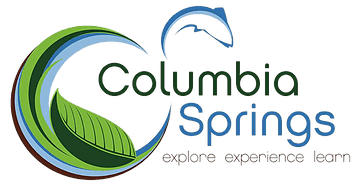Luke Hossler collects a water quality sample, 2019.
“What surprised me most was the resilience of the landscape.”
Miranda Roberts is a senior Environmental Science Major at Multnomah University – part of a team of student scientists working at Columbia Springs this fall. The one hundred acre natural area is boxed in by roads, freeways and neighborhoods, which are prone to being major sources of runoff pollution, so the students expected that their data would indicate higher levels of contamination. But after months of monitoring, and years of data collection from other cohorts of students, the water at Columbia Springs continues to be suitable for salmon and trout.
“I believe these levels remaining in the optimal range may be due to the preservation of the vegetation and forest area surrounding all water sources” reports Miranda, who along with her team presented data to Columbia Springs staff last December. This key observation about the impact of land use on water quality, is exactly what is possible when students have the opportunity to step out of a classroom and into the forest for science learning. That ability to take a step back and notice the context and complex systems at work surrounding a waterway is the higher order thinking that our world needs.
“Water quality metrics start to come alive when students can tie them to a particular ecosystem” notes Jason Stuckey, Ph.D. and Associate Professor of Environmental Science at Multnomah State University. “My students appreciate the opportunity to work in the field and find it gratifying that the environmental science work they are performing is meaningful.”
During the student’s presentation they noted that one of the sample locations, a distribution box that redirects fresh spring water toward fish rearing operations, was showing higher than expected levels of nitrates. Although some amount of nitrates are naturally occurring, high levels can indicate pollution entering the waterway like fertilizer runoff. This could happen for a number of reasons, including if some houses in the neighborhood upstream of Columbia Springs were choosing to fertilize their lawns.

Nitrate levels found at Columbia Springs during student water quality monitoring project.
Columbia Springs staff and the hatchery specialists at Washington Department of Fish and Wildlife are able to take this information into consideration as fish rearing operations and maintenance are planned, but questions remain. Did the high nitrate levels occur as a result of leaf litter build up in the distribution box? Or, is there an increase in pollution entering our waterways that we might have an opportunity to identify, remediate or eliminate?

Miranda Roberts has chosen to complete her senior capstone project at Columbia Springs, digging deeper into nitrate levels across the site.
Unfortunately, like many organizations with small teams and budgets, staff time is not always available to pursue all the scientific monitoring projects that could provide useful information for managing the Columbia Springs site. That is why partnerships with local students are critical, not only for providing opportunities to our next generation of scientists, but because student and citizen science can provide useful and meaningful data that can fill gaps in knowledge and inform best management practices.
Thankfully, Miranda has decided to use her senior capstone project to continue working on monitoring projects at Columbia Springs, because she sees value for her own learning and a way to contribute positively to her community. “The variability of the natural landscape pushed us to think outside of the box in ways we wouldn’t have otherwise,” she said. “This was a great learning experience for us all and we are so grateful for Columbia Springs’ collaboration.”

